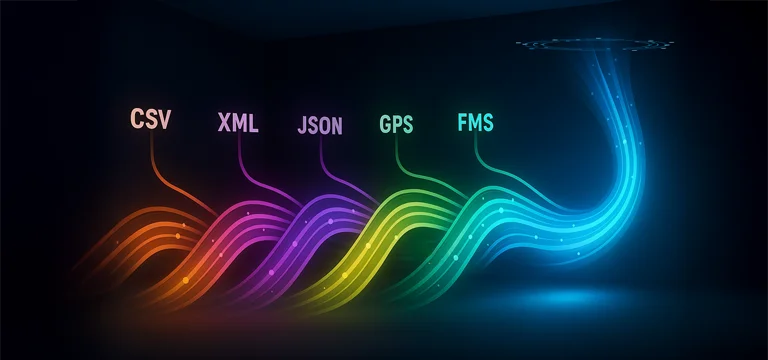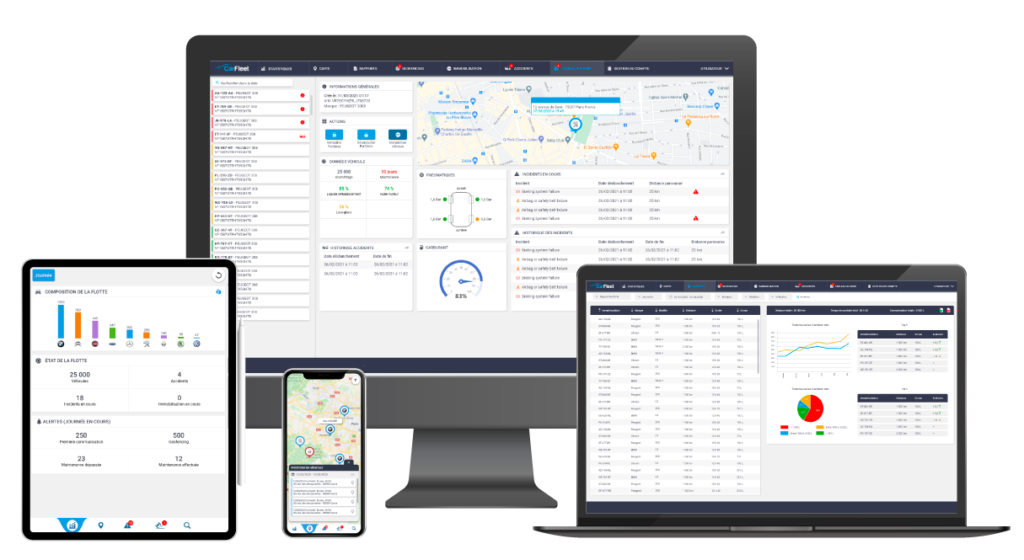
Understanding Fleet Data: FMS Standard and GPS Formats Explained
Table of contents
Introduction
In many fleets, data management is becoming increasingly complex. Different sources (from GPS trackers and fuel card data to OEM portals) provide information in various formats: CSV, XML, JSON, or specific GPS files. Fleet managers thus face the challenge of efficiently consolidating, analyzing, and working with this data.
Yet few fleet operators are data experts. The result: compatibility issues, lengthy processes, lost information, and frustration. Without consolidation in a unified system, much potential remains untapped.
In this article, you will learn everything about the most important formats, the FMS standard, typical issues in fleet management, and how a modern solution like CarFleet by Echoes can help.
Why Unified Data Formats Are Essential
Vehicle data is a valuable resource for fleet managers, especially when it comes to GPS vehicle tracking, maintenance planning, and optimizing operational costs. But when this data is available in various, incompatible formats for your system, problems arise quickly:
High manual effort: Data must be converted by hand
Error-proneness: Incorrect assignments or formatting errors can lead to misinterpretations
Delayed decisions: Without up-to-date and uniform data, strategic decisions become more difficult
Increased IT costs: Custom interface development consumes budget and resources
A smooth data flow is therefore no longer a “nice-to-have” but a prerequisite for efficient fleet management.
The Most Important Data Formats: CSV, XML & Excel
The data collected in fleet management comes from diverse sources and is provided in different file formats depending on the provider, hardware, or software. For this information to be effectively used, fleet managers must not only understand what formats like XML, JSON, or GPX are, but also how to open and process them.
Below, we present the most important data formats in fleet management in detail – including origin, typical use cases, strengths and weaknesses, and tips for practical use.
CSV & Excel Formats
CSV files (Comma-Separated Values) store data row by row, with individual values separated by commas (or semicolons). In fleet management, CSV files are especially used to export or share data such as fuel invoices, trip logs, or driver data from various sources.
Microsoft Excel – the world’s most widely used spreadsheet program – handles CSV files with ease and allows for data visualization and further processing.
Use cases: Fuel data exports, vehicle lists, driver data, manual fleet analyses
Advantages:
Universal exchange format, very widespread
Easily editable with Excel, Google Sheets, or similar programs
Ideal for simple table structures
Disadvantages:
No support for nested or complex data
Lacks format validation, which can lead to misinterpretations
Open with: Excel, Google Sheets, OpenOffice Calc, Notepad, VS Code
XML (Extensible Markup Language)
Use cases: Leasing and maintenance documents, insurance data, vehicle information
Advantages:
Highly structured format, suitable for complex content
Widely used in system-to-system communication
Disadvantages:
Laborious to edit manually
Large storage requirements for extensive documents
Open with: Web browser, XML editors (e.g., XML Notepad, Oxygen XML), Excel (via data import), VS Code
Special Formats: JSON and GPS Data Formats
JSON (JavaScript Object Notation)
JSON was introduced in the 2000s as a compact exchange format for web applications and is ideal for transmitting dynamic data via APIs.
In fleet management, JSON is mainly used to transmit live data such as GPS positions or vehicle statuses from telematics systems.
Use cases: API-based systems, GPS tracking, real-time vehicle diagnostics
Advantages:
Compact, efficient, and easily processed by systems
Ideal for integration with modern web and cloud applications
Disadvantages:
Hard to read without formatting
Low tolerance for structural errors
Open with: JSON viewers (web tools), Postman, Excel (Power Query), Notepad++, VS Code
GPS Data Formats (e.g., GPX, KML, NMEA)
GPS data formats are used to store location, time, and movement information. GPX and KML are XML-based standards, while NMEA is a compact ASCII data stream often transmitted in real-time via serial interfaces. These formats are essential in fleet management for route tracking, tour planning, and vehicle movement documentation.
Use cases: Live tracking, trip archiving, route optimization, geofencing
Advantages:
High accuracy in location data
Broad compatibility with mapping software and analytics platforms
Disadvantages:
Varying formats depending on the provider
Requires conversion for data consolidation
Open with: Google Earth (KML), GPS Visualizer, QGIS, telematics portals, specialized GIS software
Interfaces: OEM Data and API Interfaces
OEM Data (Original Equipment Manufacturer)
OEM data comes directly from vehicle manufacturers and is accessible via diagnostic interfaces or cloud-based vehicle portals. It includes vehicle-specific information such as mileage, maintenance notices, engine data, or error codes. These data formats are usually proprietary and vary from manufacturer to manufacturer.
Use cases: Vehicle condition monitoring, maintenance and repair forecasting, VIN-based queries
Advantages:
High-quality, precise vehicle data directly from the manufacturer
Enables detailed component-level analysis
Disadvantages:
No uniform standard across manufacturers, making integration difficult
Access usually only available via licensed interfaces
Open with: OEM portals (e.g., Mercedes-Benz Uptime, Scania Communicator), specialized diagnostic tools
API Interfaces (e.g., REST, SOAP)
An API (Application Programming Interface) is not a file in the traditional sense, but a digital interface through which systems can automatically exchange data. REST and SOAP are the most common formats. APIs are the foundation for real-time communication between fleet management systems, telematics, ERP, and third-party providers.
Use cases: Real-time data integration, system networking, automated workflows
Advantages:
Current, synchronous data flows
Standardized communication between any systems
Disadvantages:
Requires technical expertise for setup and maintenance
Interface maintenance needed during system updates
Used with: Postman, Swagger, custom API integrations, low-code platforms (e.g., Make, Zapier)
These formats form the technological foundation for digital fleet management. However, only through standardization – such as with the FMS System – can their use become efficient and scalable.
What is the FMS Standard?
The Fleet Management System (FMS) is a cross-manufacturer standard introduced in 2002 by leading European commercial vehicle manufacturers such as Daimler, MAN, Scania, Volvo, DAF, and IVECO. The goal was to create a unified interface for standardized vehicle telematics data—independent of the manufacturer.
Numerous operational data can be read via the FMS interface, including:
Speed (from wheel and tachograph)
Accelerator pedal position
Use of brake, clutch, and cruise control
Fuel consumption, tank level, engine RPM
PTO status (power take-offs)
Engine temperature, axle load, engine hours
Vehicle Identification Number (VIN)
Information from the digital tachograph
These parameters provide a comprehensive view of the condition and driving behavior of commercial vehicles and help fleet managers plan maintenance, analyze driving styles, and meet regulatory requirements (e.g., driving times).
Advantages of the FMS Standard:
Manufacturer-independent access to standardized vehicle data
Better comparability of vehicle performance
Basis for fleet analysis, maintenance planning, and driving behavior evaluation
Disadvantages and Problems:
Not every OEM offers the FMS interface as standard (e.g., only DAF does across all models)
Often requires retrofitting in older vehicles (e.g., via CAN bus adapter)
FMS only offers basic data – no in-depth OEM-specific diagnostics
Simplifying Data Harmonization with CarFleet
As helpful as the FMS interface is as a common data foundation – in practice, standardized vehicle data alone is often not enough. That’s because they encounter a variety of additional formats, individual OEM systems, and isolated tools that don’t easily communicate with one another. This is where the problem lies: the data exists but is not connected, not comparable, and difficult to use.
CarFleet by Echoes bridges this gap. The platform combines standardized FMS data with additional vehicle and telematics data from various manufacturers and systems. Through direct OEM integrations, modern APIs, and intelligent data harmonization, all relevant information is brought together—in a central system, ready to use. No extra hardware, no manual effort—but full visibility over your entire fleet.
From FMS Interface to Full Integration

Harmonized data from various manufacturers in a single system
Real-time monitoring of all vehicles via a central platform
Seamless integration into existing operational and maintenance systems
Proactive maintenance planning based on actual need instead of rigid intervals
Automatic transmission of vehicle status
Unified Vehicle Data as the Key to Modern Fleet Control
The diversity of data formats can be both a curse and a blessing: different formats such as CSV, XML, JSON, GPS, or proprietary OEM data provide valuable information—but often remain isolated in their respective systems. Even the cross-manufacturer FMS standard offers only part of the solution, as it is limited to basic data and doesn’t cover all vehicle models.
The central challenge lies in harmonizing all these data sources: only those who have a real-time overview of vehicle condition, trip data, maintenance needs, and driving behavior can reduce costs, avoid breakdowns, and reliably meet legal requirements.
CarFleet by Echoes offers a smart solution: the platform integrates FMS and OEM data without additional hardware, clearly prepares all information, and can be seamlessly integrated into existing systems. The result is a modern, scalable fleet management system—efficient, transparent, and ready for the mobility of tomorrow.